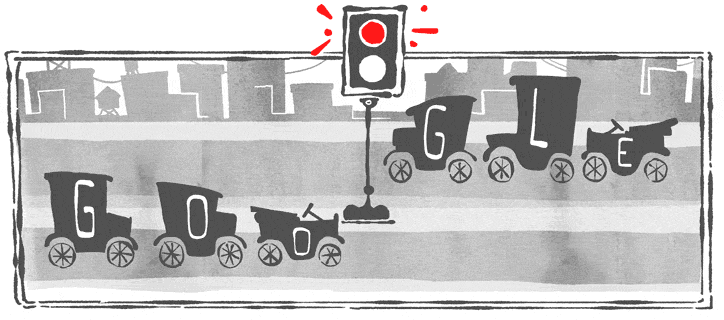
The early twentieth-century intersection was a strange scene. While the world’s largest automobile manufacturer sold over 20,000 cars a month in 1914, horse-drawn wagons and carts still crowded the streets, and accidents became increasingly frequent. Intersections in major cities were congested, and traffic was directed by police officers who stood in the middle of chaotic highways waving their arms–an unenviable beat, to say the least, especially during a blustery winter in the Midwest.
A solution to the problem was woefully overdue. Gas-lit stoplights appeared in England before the turn of the century, but these had a tendency to explode, and mechanically operated signs that displayed the words “stop” and “move” still relied on traffic attendants. Enter the inspiration of today’s Doodle, the electric traffic signal, which was first installed at the corner of 105th and Euclid in Cleveland, Ohio on August 5th, 1914.
My morning started with the google doodle above, which led (as is usual for me) to a tweet:
#googledoodle 101st anniversary of the traffic light – note: in South Africa these are called robots. Yes: ROBOTS. https://t.co/3YAQTblnaT
— sheree bekker (@shereebekker) August 5, 2015
I have been wondering all day why I grew up (in South Africa) saying “turn left at the next robot” – which has often led to strange looks and hilarious consequences now that I live in Australia!
Wikipedia revealed that:
The etymology of the word robot (traffic light) derives from a description of early traffic lights as robot policemen, which then got truncated with time
While in South Africa this is simply a matter of semantics, it seems that another country in Africa has taken this likeness a step further. This same google search for the traffic light/robot connection led me to this recent article: Robocops being used as traffic police in Democratic Republic of Congo.
Yes: large solar-powered ROBOCOPS!
A follow-up piece: Kinshasa’s traffic robots: ‘I thought it was some kind of joke’ – in pictures is fascinating!
These robocops were developed by a Congolese association of women engineers, to tackle the problem of traffic safety in Kinshasa in a novel way:
“In our city, someone can commit an offence and run away, and say that no one saw him. But now, day or night, we’ll be able to see him in real time and he will pay his fine” ~ Therese Izay
Whilst I did not do a comprehensive search, I failed to find any research underpinning the Robocop initiative (if you know of any please share!). Sure, at first glance, injury prevention researchers will have questions about the issues potentially inherent to the robocop initiative – but many of us are also mightily privileged in the resources at our disposal (which is why the open access movement is vitally important), and, crucially, have never been to Kinshasa. Approaches to solve problems that have worked in some contexts will not necessarily work in others. The real world demands nuance, and is complex.
What this does show is that people in the Democratic Republic of Congo are willing to look outside the box to new innovations to make their cities safer. It is time to look at old problems in new ways. We often forget that innovation and creativity can be the lifeblood of academic research too. How can we all add little more playful creativity to our work to seek to find these innovative solutions? Bridie Scott-Parker has written here before that we should look for injury prevention ideas everywhere.
Perhaps this world DOES need more robocops after all!